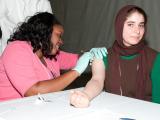Flu activity rose again last week, nearly reaching the seasonal baseline, with all three strains circulating and subtypes varying by region and age, the US Centers for Disease Control and Prevention (CDC) said in its weekly update today.
Nationally, one of the main markers—the percentage of clinic visits for flulike illness—rose to 2.3%, putting it just below the 2.4% baseline. However, four of the country's regions are above their specific baselines, and more states are reporting high and widespread flu activity.
Hot spots mainly in southern states
Parts of the country where flu is at or above baseline include southeastern, south central, central Midwest, and southwestern states.
The flu activity map, another indicator of clinic visits for flu, shows that Louisiana is reporting high levels, with Puerto Rico and five states (Alabama, Georgia, Mississippi, South Carolina, and Texas) reporting moderate activity.
Regarding geographic spread, flu is widespread in three states, up from two the previous week. They are California, Louisiana, and Maryland.
Influenza B predominant, but all strains circulating
The CDC said the influenza B Victoria lineage virus is currently predominant, which is unusual for this early in the flu season. Usually, influenza B activity rises late in the Northern Hemisphere’s season. However, there was little activity from the subtype in the latter part of the 2018-2019 season.
However, the agency added that all three strains are circulating, with patterns that vary by region and patient age. At public health laboratories last week, 59% of specimens that tested positive for flu were influenza B and 41% were influenza A. And of the subtyped influenza A viruses, 61.5% were 2009 H1N1 and 38.5% were H3N2.
Influenza B was most common in people younger than 24 years old and H3N2 was most common in seniors. In adults ages 24 to 64, equal proportions of all three strains have been reported.
Regional patterns show that influenza B is more common in the south and southeast, 2009 H1N1 is more frequently detected in the central states, and H3N2 is more common in the northeast.
Two more pediatric flu deaths
Last week, two more pediatric flu deaths were reported to the CDC, one from the previous season and one from the current season. The reports push last season's total to 143. The death from the current season was linked to influenza B, raising this season’s total to three.
The overall percentage of deaths from pneumonia and flu—which typically rises later in the flu season—was 4.9% last week, well below the 6% epidemic threshold.
Health officials recommend that everyone age 6 months and older be vaccinated against flu, preferably by the end of October.
Flu vaccine makers expect to make between 162 million and 169 million doses for the US market. According to the CDC, as of Nov 11, companies had distributed 162.1 million doses.
See also:
Nov 15 CDC FluView report
Nov 15 CDC flu vaccine distribution update




















